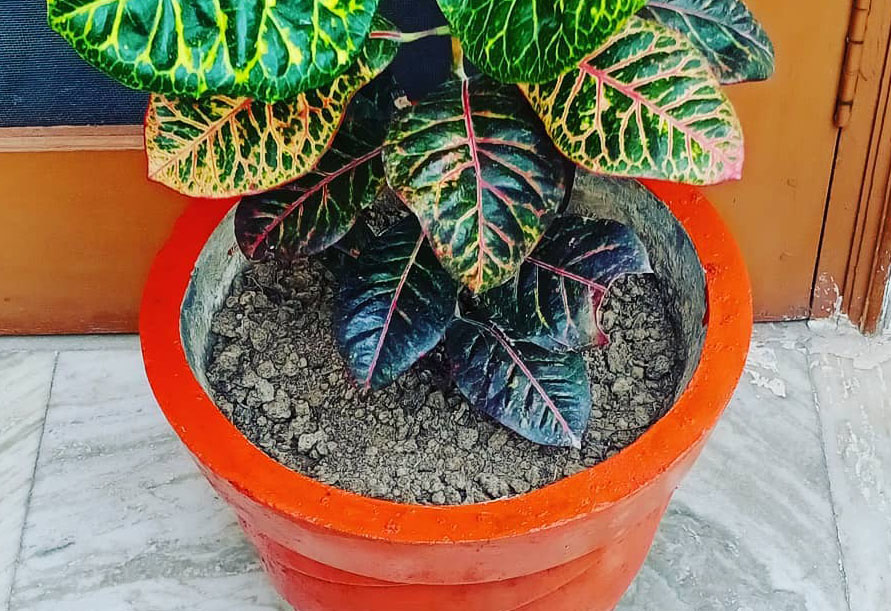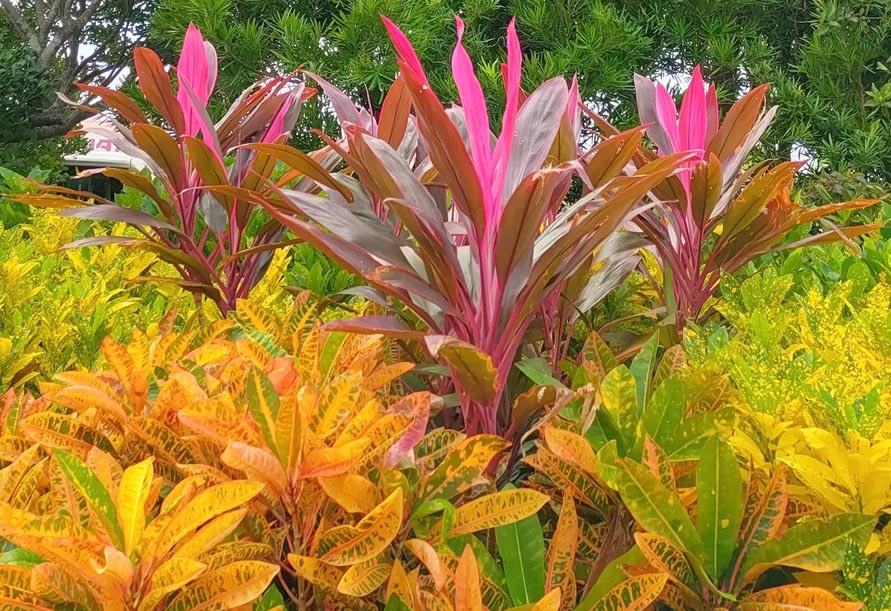Croton

Croton is one of the most beautiful Tropical Plants and has attracted many people because of its leaves’ appearance and beautiful color. One of the features of this plant is orange, brown, purple, and pink spots with a dark green background that gives a special effect to the corticosteroid plant. The croton plant, scientifically known as Codiaeum variegatum, grows best in warm, humid environments and is native to Malaysia, Australia, Indonesia, and the western Pacific islands. It is one of the plants of tropical Asia and the Pacific, which is an ideal choice for home use due to its leaves’ beauty and unique color combination. In this article, we want to make you more familiar with the properties of the croton plant and its storage conditions at home and in the apartment. Please read on with Alo Plant.
| Botanical Name | Codiaeum variegatum |
| Common Name | Croton, Garden Croton, Puding, Joseph’s Coat, Variegated Croton, Variegated Laurel, Codiaeum |
| Plant Type | Evergreen, tropical |
| Pet / Baby Safe | Toxic to humans and pets |
| Sun Exposure | Full, partial |
| Hardiness Zones | 9 to 11 |
| Bloom Time | Year-round, although indoor plants rarely flower |
| Soil Type | Moist, well-draining |
| Flower Color | Yellow |
| Foliag Color | purple, green, yellow, red, orange and pink |
| Plant Height | 36 to 100 inches tall, 36 to 72 inches wide |
| Native Area | Tropical Asia and Pacific regions |
how to take care of croton plant?

Croton is a member of the Aphrodisiac family that grows in the forests of Southeast Asia. Crotons are sun-loving plants, but that does not mean that you can keep them in direct sunlight, as most species of crotons do not stay healthy in direct sunlight. But among all the species of this plant, those with different colors in their leaves need more light than other species. Today, about 700 species of crotons have been found, each with unique characteristics and adapting to different environments.
how tall do crotons grow?
The height of this plant inside the pot reaches one meter and up to three meters in nature. Crotons have white seasonal flowers that separate on the inflorescence and grow to a length of 8 to 30 cm.
croton temperature
As mentioned, the croton plant belongs to the world’s tropical regions and prefers warm weather. Therefore, it grows well at temperatures between 17 and 23 degrees Celsius. It is recommended that you do not place this plant near heating devices. Because successive changes in temperature cause the leaves to turn brown and disappear.
croton watering
Croton is a moisture-friendly plant that needs between 40 and 80 percent moisture, which is naturally better if humidity tends to increase. It is better to make an island under the pot and spray the leaves once or twice a week to provide water. Regarding irrigation, it should be said that the soil needs mild moisture, but like most houseplants, excessive soil moisture and wetting of the roots will lead to root rot, so irrigate carefully. Irrigation can usually be done by drying a few inches of the soil surface, but the plant should not be thirsty and experience complete dryness. It is recommended to water the croton plant 2 to 3 times a week in summer.
croton soil

The soil texture of the plant should be such that it has a high drainage capacity. The best soil composition for planting and maintaining crotons is a combination of 3 parts leaf or perlite soil, two parts garden soil, and 1 part soft sand. Using heavy soil for planting and maintaining crotons or using only garden soil will cause water to remain next to the plant and lead to root rot.
croton leaves cleaning

To maintain the croton flower, you must clean its leaves once a week. Since the leaves of this plant have a large surface area, you must keep the plant leaves away from dust to breathe and perform photosynthesis. Do this with a cotton swab, then use chlorine-free water to clean the plant leaves. You should never use chemicals to clean your plant leaves as they close the leaf holes.
croton light requirements

Keeping this beautiful flower exposed to direct light would be a mistake because it causes the leaves to dry out and fall off. Although this plant is sun-loving, it indirectly likes light. You can place this flower in the sun for two hours a day on average on hot days of the year to meet its needs. If you use this flower at home and there is not enough light in your house, you can use plant growth lamps. As much as possible, try to move the pot of this plant less because it needs a stable environment and maybe shocked and destroyed by this action.
propagate croton

In general, the croton plant propagation is done in two ways: cuttings and aerial dormancy. In the following, we will explain how to implement these two methods:
1) Croton cuttings in the soil:
One of the suitable and ideal methods for propagating crotons is cutting them in the soil. To do this, we first separate the young cuttings from the stem to a length of 8 to 15 cm; it is better to use a clean and disinfected knife so that the plant itself and even the cuttings do so not become dirty and dirty. For the plant to spend all its energy on rooting, try to separate most of the leaves except the upper 2.3 leaves. For better results, you can put the cuttings in the rooting hormone. Then you have to put the pot with the cuttings in a bright place and cover it with transparent plastic.
2) Croton cuttings in water:
This method is not much different from the previous method, but it is suitable for propagating crotons, and as mentioned, you should prepare cuttings with a length of 8 to 15 cm and separate the lower half of all of them. Do this in such a way that only two or finally three leaves remain at the end. Now put the cuttings in a water container and move it to a warm and bright place. If the cuttings are in excellent and favorable conditions, they will take root after 3 to 4 weeks, after the seeds have grown a little longer. You can transfer them to pots.
The importance of croton spraying
Croton should be sprayed once a week in winter and daily in summer. Because this plant needs a lot of moisture. (Also, note that direct sunlight should not be sprayed because it causes brown and burnt spots such as on the leaves of the plant)
fertilizer for crotons
The most suitable fertilizer for crotons is the fertilizer that is entirely organic and natural. This fertilizer should contain valuable elements such as; Contains iron, boron, phosphorus, zinc, potassium, magnesium, nitrogen, amino acids, nitrogen, and و and provides all the nutrients to the plant. It is usually recommended once every two weeks; Use water-soluble nutrients and fertilizers to irrigate crotons.
croton pests and diseases
Yellowing of leaves
Lack of light and dark storage environment sometimes cause paleness and yellowing of croton leaves. To prevent this problem, it should be transferred to a bright place.
Falling leaves
Changes and fluctuations in air temperature cause croton leaves to fall off in the long run. To avoid this problem, consider a constant temperature for storage.
Creating brown spots on the leaves
Exposure to petroleum gases or the kitchen environment can sometimes cause brown spots on the croton leaves. You should move the plant to a clean, air-conditioned environment to solve this problem.
Inadequate leaf shape
This problem indicates that there are not enough nutrients in the soil. To solve this problem, fertilizers containing nutrients should be used for the plant.
Conclusion
Croton This evergreen plant has a beautiful appearance with orange, brown, purple, and pink spots with a dark green background that gives a special effect to the Corton plant and is always one of the attractive options for use in homes and apartments. This species is primarily found in Malaysia, Australia, Indonesia, and the western Pacific islands and is a poisonous plant for pets and infants. Croton has been used as a houseplant in many countries. You can breed and propagate them by knowing their maintenance systems, such as suitable ambient temperature, soil conditions, and suitable distances for irrigation. In this article, we will give you a reasonably comprehensive overview of maintaining croton. If you have any questions or concerns about this issue, please contact us in the comments section.
RELATED POSTS













